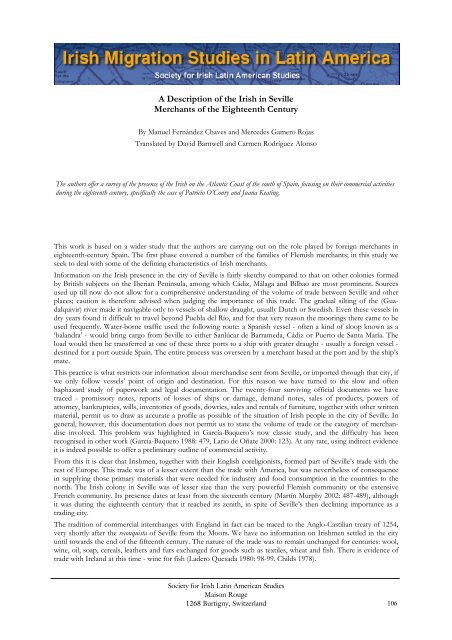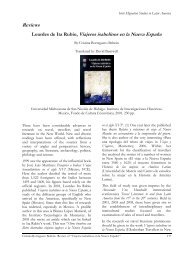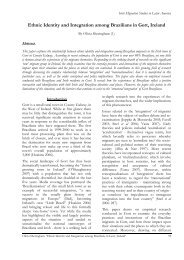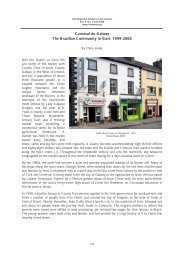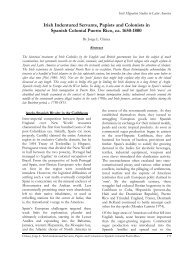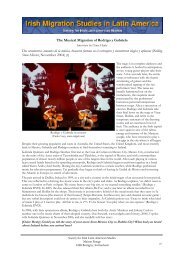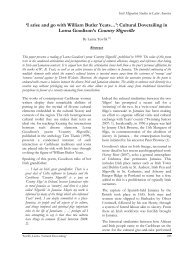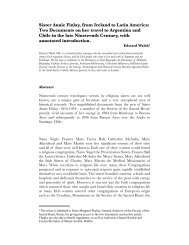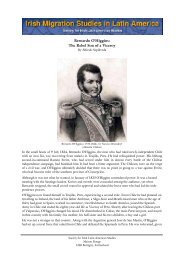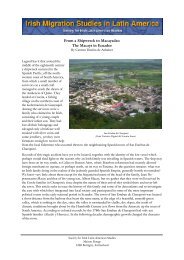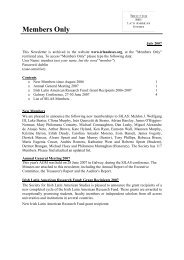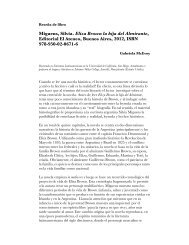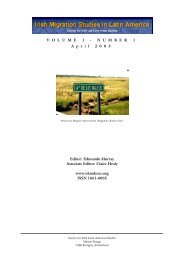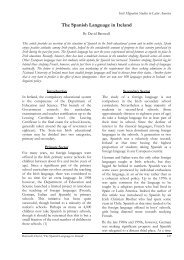A Description of the Irish in Seville Merchants of the Eighteenth ...
A Description of the Irish in Seville Merchants of the Eighteenth ...
A Description of the Irish in Seville Merchants of the Eighteenth ...
Create successful ePaper yourself
Turn your PDF publications into a flip-book with our unique Google optimized e-Paper software.
A <strong>Description</strong> <strong>of</strong> <strong>the</strong> <strong>Irish</strong> <strong>in</strong> <strong>Seville</strong><strong>Merchants</strong> <strong>of</strong> <strong>the</strong> <strong>Eighteenth</strong> CenturyBy Manuel Fernández Chaves and Mercedes Gamero RojasTranslated by David Barnwell and Carmen Rodríguez AlonsoThe authors <strong>of</strong>fer a survey <strong>of</strong> <strong>the</strong> presence <strong>of</strong> <strong>the</strong> <strong>Irish</strong> on <strong>the</strong> Atlantic Coast <strong>of</strong> <strong>the</strong> south <strong>of</strong> Spa<strong>in</strong>, focus<strong>in</strong>g on <strong>the</strong>ir commercial activitiesdur<strong>in</strong>g <strong>the</strong> eighteenth century, specifically <strong>the</strong> case <strong>of</strong> Patricio O’Conry and Juana Keat<strong>in</strong>g.This work is based on a wider study that <strong>the</strong> authors are carry<strong>in</strong>g out on <strong>the</strong> role played by foreign merchants <strong>in</strong>eighteenth-century Spa<strong>in</strong>. The first phase covered a number <strong>of</strong> <strong>the</strong> families <strong>of</strong> Flemish merchants; <strong>in</strong> this study weseek to deal with some <strong>of</strong> <strong>the</strong> def<strong>in</strong><strong>in</strong>g characteristics <strong>of</strong> <strong>Irish</strong> merchants.Information on <strong>the</strong> <strong>Irish</strong> presence <strong>in</strong> <strong>the</strong> city <strong>of</strong> <strong>Seville</strong> is fairly sketchy compared to that on o<strong>the</strong>r colonies formedby British subjects on <strong>the</strong> Iberian Pen<strong>in</strong>sula, among which Cádiz, Málaga and Bilbao are most prom<strong>in</strong>ent. Sourcesused up till now do not allow for a comprehensive understand<strong>in</strong>g <strong>of</strong> <strong>the</strong> volume <strong>of</strong> trade between <strong>Seville</strong> and o<strong>the</strong>rplaces; caution is <strong>the</strong>refore advised when judg<strong>in</strong>g <strong>the</strong> importance <strong>of</strong> this trade. The gradual silt<strong>in</strong>g <strong>of</strong> <strong>the</strong> (Guadalquivir)river made it navigable only to vessels <strong>of</strong> shallow draught, usually Dutch or Swedish. Even <strong>the</strong>se vessels <strong>in</strong>dry years found it difficult to travel beyond Puebla del Río, and for that very reason <strong>the</strong> moor<strong>in</strong>gs <strong>the</strong>re came to beused frequently. Water-borne traffic used <strong>the</strong> follow<strong>in</strong>g route: a Spanish vessel - <strong>of</strong>ten a k<strong>in</strong>d <strong>of</strong> sloop known as a‘balandra’ - would br<strong>in</strong>g cargo from <strong>Seville</strong> to ei<strong>the</strong>r Sanlúcar de Barrameda, Cádiz or Puerto de Santa María. Theload would <strong>the</strong>n be transferred at one <strong>of</strong> <strong>the</strong>se three ports to a ship with greater draught - usually a foreign vessel -dest<strong>in</strong>ed for a port outside Spa<strong>in</strong>. The entire process was overseen by a merchant based at <strong>the</strong> port and by <strong>the</strong> ship’smate.This practice is what restricts our <strong>in</strong>formation about merchandise sent from <strong>Seville</strong>, or imported through that city, ifwe only follow vessels’ po<strong>in</strong>t <strong>of</strong> orig<strong>in</strong> and dest<strong>in</strong>ation. For this reason we have turned to <strong>the</strong> slow and <strong>of</strong>tenhaphazard study <strong>of</strong> paperwork and legal documentation. The twenty-four surviv<strong>in</strong>g <strong>of</strong>ficial documents we havetraced - promissory notes, reports <strong>of</strong> losses <strong>of</strong> ships or damage, demand notes, sales <strong>of</strong> products, powers <strong>of</strong>attorney, bankruptcies, wills, <strong>in</strong>ventories <strong>of</strong> goods, dowries, sales and rentals <strong>of</strong> furniture, toge<strong>the</strong>r with o<strong>the</strong>r writtenmaterial, permit us to draw as accurate a pr<strong>of</strong>ile as possible <strong>of</strong> <strong>the</strong> situation <strong>of</strong> <strong>Irish</strong> people <strong>in</strong> <strong>the</strong> city <strong>of</strong> <strong>Seville</strong>. Ingeneral, however, this documentation does not permit us to state <strong>the</strong> volume <strong>of</strong> trade or <strong>the</strong> category <strong>of</strong> merchandise<strong>in</strong>volved. This problem was highlighted <strong>in</strong> García-Baquero’s now classic study, and <strong>the</strong> difficulty has beenrecognised <strong>in</strong> o<strong>the</strong>r work (García-Baquero 1988: 479, Lario de Oñate 2000: 123). At any rate, us<strong>in</strong>g <strong>in</strong>direct evidenceit is <strong>in</strong>deed possible to <strong>of</strong>fer a prelim<strong>in</strong>ary outl<strong>in</strong>e <strong>of</strong> commercial activity.From this it is clear that <strong>Irish</strong>men, toge<strong>the</strong>r with <strong>the</strong>ir English coreligionists, formed part <strong>of</strong> <strong>Seville</strong>’s trade with <strong>the</strong>rest <strong>of</strong> Europe. This trade was <strong>of</strong> a lesser extent than <strong>the</strong> trade with America, but was never<strong>the</strong>less <strong>of</strong> consequence<strong>in</strong> supply<strong>in</strong>g those primary materials that were needed for <strong>in</strong>dustry and food consumption <strong>in</strong> <strong>the</strong> countries to <strong>the</strong>north. The <strong>Irish</strong> colony <strong>in</strong> <strong>Seville</strong> was <strong>of</strong> lesser size than <strong>the</strong> very powerful Flemish community or <strong>the</strong> extensiveFrench community. Its presence dates at least from <strong>the</strong> sixteenth century (Martín Murphy 2002: 487-489), althoughit was dur<strong>in</strong>g <strong>the</strong> eighteenth century that it reached its zenith, <strong>in</strong> spite <strong>of</strong> <strong>Seville</strong>’s <strong>the</strong>n decl<strong>in</strong><strong>in</strong>g importance as atrad<strong>in</strong>g city.The tradition <strong>of</strong> commercial <strong>in</strong>terchanges with England <strong>in</strong> fact can be traced to <strong>the</strong> Anglo-Castilian treaty <strong>of</strong> 1254,very shortly after <strong>the</strong> reconquista <strong>of</strong> <strong>Seville</strong> from <strong>the</strong> Moors. We have no <strong>in</strong>formation on <strong>Irish</strong>men settled <strong>in</strong> <strong>the</strong> cityuntil towards <strong>the</strong> end <strong>of</strong> <strong>the</strong> fifteenth century. The nature <strong>of</strong> <strong>the</strong> trade was to rema<strong>in</strong> unchanged for centuries: wool,w<strong>in</strong>e, oil, soap, cereals, lea<strong>the</strong>rs and furs exchanged for goods such as textiles, wheat and fish. There is evidence <strong>of</strong>trade with Ireland at this time - w<strong>in</strong>e for fish (Ladero Quesada 1980: 98-99. Childs 1978).Society for <strong>Irish</strong> Lat<strong>in</strong> American StudiesMaison Rouge1268 Burtigny, Switzerland106
The growth <strong>of</strong> <strong>the</strong> volume <strong>of</strong> English manufactures is closely l<strong>in</strong>ked to <strong>the</strong> correspond<strong>in</strong>g <strong>in</strong>crease <strong>in</strong> <strong>the</strong> export <strong>of</strong>high-quality Castilian wool. As is known, England was able to <strong>in</strong>crease its production <strong>of</strong> wool, though <strong>of</strong> <strong>in</strong>feriorquality, by feed<strong>in</strong>g its sheep on <strong>the</strong> abundant grass yielded by its well-watered pastures. While <strong>the</strong> production <strong>of</strong>high-quality wool <strong>in</strong> England decreased, <strong>the</strong>re was an <strong>in</strong>crease <strong>in</strong> demand for high quality fabrics. This obligedEnglish manufacturers to look elsewhere for <strong>the</strong>ir supply and to come to Spa<strong>in</strong> <strong>in</strong> search <strong>of</strong> what was <strong>the</strong>n <strong>the</strong> f<strong>in</strong>estwool available <strong>in</strong> Europe. More than half <strong>the</strong> wool exported by Castile left through <strong>the</strong> port <strong>of</strong> Bilbao <strong>in</strong> <strong>the</strong>eighteenth century, and wool exports <strong>in</strong>creased even more to satisfy <strong>the</strong> demand <strong>of</strong> countries such as Holland andFrance (Bilbao, Fernández de P<strong>in</strong>edo 1986: 343-359).The great success story <strong>of</strong> Castilian wool, it appears, is above all someth<strong>in</strong>g that evolved <strong>in</strong> <strong>the</strong> eighteenth century. In1795 Castilian wool sent to England represented 60% <strong>of</strong> <strong>the</strong> total volume exported, a large <strong>in</strong>crease compared to <strong>the</strong>previous period. More <strong>in</strong>terest<strong>in</strong>g still is England’s loss <strong>of</strong> <strong>in</strong>terest <strong>in</strong> import<strong>in</strong>g <strong>Irish</strong> wool. At <strong>the</strong> beg<strong>in</strong>n<strong>in</strong>g <strong>of</strong> <strong>the</strong>century this represented 90%, while by <strong>the</strong> 1740s it amounted to only half <strong>the</strong> wool imported. Demand <strong>in</strong> Englandswitched decisively towards raw material <strong>of</strong> higher quality (Bilbao 1998). This circumstance, toge<strong>the</strong>r with difficultiesoccasioned by <strong>the</strong> heavy tax on <strong>the</strong> export abroad <strong>of</strong> articles <strong>of</strong> <strong>Irish</strong> wool that was imposed by <strong>the</strong> Anglo-<strong>Irish</strong>parliament <strong>in</strong> 1698, and <strong>the</strong> fur<strong>the</strong>r tax <strong>the</strong> English parliament imposed <strong>in</strong> <strong>the</strong> same year on <strong>the</strong> import <strong>of</strong> <strong>Irish</strong>goods to England and Wales, caused many <strong>Irish</strong> merchant families to emigrate for economic reasons. These jo<strong>in</strong>ed<strong>the</strong> Wild Geese, who a generation earlier had gone <strong>in</strong>to exile follow<strong>in</strong>g <strong>the</strong> military defeats at <strong>the</strong> Boyne <strong>in</strong> 1690 andAughrim <strong>in</strong> 1691 and <strong>the</strong> repression that followed <strong>the</strong>se defeats (O’Beirne Ranelagh 1999: 74-76).The role <strong>of</strong> <strong>the</strong> <strong>Irish</strong> <strong>in</strong> Spanish trade with Europe: A survey <strong>of</strong> <strong>the</strong> <strong>Eighteenth</strong> CenturyIf <strong>the</strong>re is one city <strong>in</strong> which <strong>the</strong> Anglo-<strong>Irish</strong> colony was important it is Cádiz, headquarters <strong>of</strong> <strong>the</strong> monopoly tradewith <strong>the</strong> Americas and Spa<strong>in</strong>’s ma<strong>in</strong> port <strong>in</strong> <strong>the</strong> eighteenth century. There <strong>the</strong>y formed one <strong>of</strong> <strong>the</strong> most <strong>in</strong>fluentialcommercial colonies <strong>of</strong> <strong>the</strong> eighteenth century, after <strong>the</strong> French and <strong>the</strong> Spaniards, although with a much largervolume <strong>of</strong> earn<strong>in</strong>gs on an <strong>in</strong>dividual basis (García Fernández 2005: 32-34). The <strong>Irish</strong> were <strong>the</strong> dom<strong>in</strong>ant section <strong>of</strong><strong>the</strong> Anglo-<strong>Irish</strong> community, probably because <strong>the</strong>y enjoyed preferential treatment as compared to <strong>the</strong>ir Englishcoreligionists, even though <strong>the</strong>y too were subjects <strong>of</strong> His Britannic Majesty. For example, <strong>the</strong>y did not have toparticipate <strong>in</strong> <strong>the</strong> registration <strong>of</strong> foreigners, such as was carried out <strong>in</strong> 1791 and 1794. This was because ‘<strong>the</strong> <strong>Irish</strong>settled <strong>in</strong> <strong>the</strong>se K<strong>in</strong>gdoms must be allowed hold and ma<strong>in</strong>ta<strong>in</strong> <strong>the</strong> privileges awarded <strong>the</strong>m which give <strong>the</strong>m paritywith natural-born Spaniards... <strong>in</strong> which regard once settled <strong>in</strong> <strong>the</strong>se k<strong>in</strong>gdoms <strong>the</strong>y are accepted as Spaniards and doenjoy <strong>the</strong> same rights accord<strong>in</strong>g to <strong>the</strong> decrees that have been issued’ (Lario de Oñate, 2000: 100, 124-130, 132-133,137). The <strong>Irish</strong> benefited from <strong>the</strong>ir situation by be<strong>in</strong>g able to avoid restrictions, and <strong>the</strong> conflicts between <strong>the</strong> twok<strong>in</strong>gdoms <strong>of</strong> Spa<strong>in</strong> and England, and to carry on bus<strong>in</strong>ess with fewer impediments than <strong>the</strong> English.In <strong>the</strong> town <strong>of</strong> Huelva, a small foreign merchant colony also settled. It became <strong>the</strong> only customs po<strong>in</strong>t for <strong>the</strong> coast<strong>of</strong> Huelva Prov<strong>in</strong>ce, <strong>the</strong> county <strong>of</strong> Niebla and <strong>the</strong> greater part <strong>of</strong> <strong>the</strong> Andévalo region, and thus constituted adistribution centre for <strong>the</strong> towns <strong>in</strong> <strong>the</strong>se areas (Lara Ródenas, Peña Guerrero 1991). Foreign trade was dom<strong>in</strong>atedby <strong>the</strong> <strong>Irish</strong>, who exported cereal, cork and w<strong>in</strong>e (González Cruz 1991), and ma<strong>in</strong>ta<strong>in</strong>ed close relations with Cádiz.The first <strong>Irish</strong> to settle <strong>in</strong> Huelva were Thomas and Pablo White or Blanco, bro<strong>the</strong>rs <strong>of</strong> Guillermo Blanco, who hadsettled <strong>in</strong> <strong>Seville</strong>, and also related to o<strong>the</strong>r Blancos resident <strong>in</strong> Cádiz. Coupled with <strong>the</strong>se was <strong>the</strong> Archdek<strong>in</strong> orArcediano family (Gozálvez Escobar 1991: 271-292), from Waterford, and <strong>the</strong> Wadd<strong>in</strong>gs from Carrick. Thesefamilies engaged primarily <strong>in</strong> <strong>the</strong> wholesale and retail trade and <strong>in</strong> shipp<strong>in</strong>g.In Málaga <strong>the</strong>re was also an <strong>Irish</strong> colony - among o<strong>the</strong>r foreign communities - <strong>in</strong>volved <strong>in</strong> wholesale trad<strong>in</strong>g. Thiswas much more important <strong>in</strong> <strong>the</strong> second half <strong>of</strong> <strong>the</strong> eighteenth century than <strong>in</strong> <strong>the</strong> post-Napoleonic period, whenSpaniards - many <strong>of</strong> <strong>the</strong>m from outside <strong>the</strong> region - took over <strong>the</strong> trade. Aurora Gámez and Begoña Villar havestudied <strong>the</strong> careers <strong>of</strong> <strong>the</strong>se merchants. They were frequently grouped <strong>in</strong>to ‘mixed’ companies, that is to say formed<strong>of</strong> foreigners and native Spaniards, even though <strong>the</strong> same foreigners had lived a long time <strong>in</strong> <strong>the</strong> country and hadchildren who could be considered fully Spanish.One <strong>Irish</strong>man stands out from <strong>the</strong> o<strong>the</strong>rs. Juan Murphy, a native <strong>of</strong> Waterford, formed part <strong>of</strong> Málaga’s wealthymerchant class from at least 1776. The family established branches <strong>of</strong> his company <strong>in</strong> Veracruz (Mexico), Cádiz andLondon, trad<strong>in</strong>g actively with cities both <strong>in</strong> Europe and <strong>in</strong> <strong>the</strong> Americas. He was also a ship-owner, a landowner,and <strong>of</strong> course an hidalgo (nobleman). Juan Galvey, from Carrick-on-Suir <strong>in</strong> County Tipperary, is an example <strong>of</strong> thosewho used marriage to open up paths for advancement <strong>in</strong> bus<strong>in</strong>ess. His first marriage was to Andrea de Gand yVittermont, member <strong>of</strong> a Flemish family settled between Cádiz and <strong>Seville</strong>. The O´Briens, who married <strong>in</strong>to <strong>the</strong>French Arboré family that had settled <strong>in</strong> those cities, cont<strong>in</strong>ued <strong>in</strong> <strong>the</strong> same l<strong>in</strong>e <strong>of</strong> bus<strong>in</strong>ess as <strong>the</strong> o<strong>the</strong>rs, while <strong>the</strong>Quilty family established sporadic relationships with merchants from <strong>Seville</strong>.The beg<strong>in</strong>n<strong>in</strong>g <strong>of</strong> commercial relations between <strong>the</strong> Canary Islands and Great Brita<strong>in</strong> dates from <strong>the</strong> sixteenthcentury, with <strong>the</strong> export <strong>of</strong> sweet malmsey w<strong>in</strong>e for <strong>the</strong> English court. The <strong>Irish</strong> colonies that grew from thisma<strong>in</strong>ta<strong>in</strong>ed close l<strong>in</strong>ks with those based <strong>in</strong> <strong>the</strong> Andalusian ports already mentioned; families such as White, Walsh,Colgan, and Fitzgerald had a long history <strong>in</strong> <strong>the</strong> Canaries (Guimerá Rav<strong>in</strong>a 1985: 49-48, 58).Fernández Chaves, Manuel and Mercedes Gamero Rojas. A <strong>Description</strong> <strong>of</strong> <strong>the</strong> <strong>Irish</strong> <strong>in</strong> <strong>Seville</strong>.........................107
<strong>Irish</strong> merchants <strong>in</strong> <strong>Seville</strong>: An <strong>in</strong>itial sketchIn spite <strong>of</strong> a slowdown <strong>in</strong> its commercial activity, it could be said that <strong>Seville</strong> cont<strong>in</strong>ued to enjoy significant traffic, asits strategic position some n<strong>in</strong>ety kilometres from <strong>the</strong> sea provided merchants with <strong>the</strong> opportunity to trade deep<strong>in</strong>land and supply <strong>the</strong> demand both <strong>of</strong> <strong>the</strong> former metropolis and <strong>of</strong> many locations <strong>in</strong> <strong>the</strong> <strong>in</strong>terior. In addition, <strong>the</strong>fertile flatlands <strong>of</strong> <strong>the</strong> Guadalquivir River pla<strong>in</strong> and surround<strong>in</strong>g areas cont<strong>in</strong>ued to supply abundant oil and citrusfruit; <strong>the</strong>se, toge<strong>the</strong>r with wool, were exported by river. Spanish trade with England <strong>in</strong> <strong>the</strong> eighteenth century had abipolar character, <strong>the</strong> two poles be<strong>in</strong>g <strong>the</strong> Cantabrian region and Andalusia. The sou<strong>the</strong>rn region was prom<strong>in</strong>ent <strong>in</strong><strong>the</strong> export <strong>of</strong> citrus fruit and products derived from grapes. With<strong>in</strong> this framework, and bear<strong>in</strong>g <strong>in</strong> m<strong>in</strong>d <strong>the</strong> freightregistries <strong>of</strong> <strong>the</strong> different Andalusian ports, <strong>Seville</strong> had a clear edge <strong>in</strong> exports, both at regional and national levels.As regards citrus fruit exports, García Fernández believes that part <strong>of</strong> <strong>the</strong> produce <strong>of</strong> <strong>the</strong> Guadalquivir river pla<strong>in</strong>region was probably exported from <strong>the</strong> port <strong>of</strong> Sanlúcar, or from Cádiz itself, to avail <strong>of</strong> <strong>the</strong> superior harbourfacilities that <strong>the</strong>se ports <strong>of</strong>fered. Never<strong>the</strong>less, she argues for <strong>the</strong> growth <strong>of</strong> <strong>the</strong> h<strong>in</strong>terland <strong>of</strong> Cádiz as a base for <strong>the</strong>mass export <strong>of</strong> citrus fruit. This supplanted <strong>the</strong> traditional export centres - <strong>Seville</strong> and Málaga - and came to supply40% <strong>of</strong> <strong>the</strong> citrus to be sold (García Fernández 2006: 291-294). However, although we have no comprehensive data,we consider – <strong>in</strong> l<strong>in</strong>e with Álvarez Pantoja (2000: 25) - that a large part <strong>of</strong> <strong>the</strong>se exports came from <strong>the</strong> regionaround <strong>Seville</strong>, s<strong>in</strong>ce, as García Fernández herself po<strong>in</strong>ts out, it is a complicated undertak<strong>in</strong>g to ascerta<strong>in</strong> <strong>the</strong> <strong>in</strong>itialpo<strong>in</strong>t <strong>of</strong> orig<strong>in</strong> <strong>of</strong> <strong>the</strong> goods sent out through <strong>the</strong> ports. This leads us to believe that, if <strong>in</strong> 1786 <strong>Seville</strong> reached <strong>the</strong>highest production figures for <strong>the</strong> entire century (550,750 units - García Fernández: 294), it could hardly have beensecondary to o<strong>the</strong>r ports, at least when it came to goods produced.Around <strong>the</strong> middle <strong>of</strong> <strong>the</strong> eighteenth century <strong>the</strong> largest group <strong>of</strong> foreign merchants <strong>in</strong> <strong>Seville</strong> were <strong>the</strong> French,although <strong>the</strong> Flemish were better represented <strong>in</strong> <strong>the</strong> city’s trade, where <strong>the</strong>y were more prom<strong>in</strong>ent than <strong>in</strong> o<strong>the</strong>rcities such as Cádiz.The establishment <strong>in</strong> <strong>Seville</strong> <strong>of</strong> <strong>the</strong>se trad<strong>in</strong>g colonies that traded from <strong>the</strong> maritime ports had its rationale <strong>in</strong> <strong>the</strong>specific k<strong>in</strong>d <strong>of</strong> activities <strong>the</strong>y were <strong>in</strong>volved <strong>in</strong>. They were nearer to <strong>the</strong> products <strong>the</strong>y exported - citrus, wool, oil -and from <strong>Seville</strong> it was easy to distribute what was imported - manufactured products, iron, fish - towards <strong>the</strong><strong>in</strong>terior <strong>of</strong> Andalusia and Extremadura. This pattern can be confirmed by study<strong>in</strong>g promissory notes <strong>in</strong> favour <strong>of</strong><strong>the</strong>se merchants, which yield <strong>in</strong>formation about advances <strong>of</strong> merchandise that were be<strong>in</strong>g <strong>of</strong>fered <strong>in</strong> exchange for adelayed payment date. As <strong>the</strong> market was extremely fragile, s<strong>in</strong>ce capacity for consumption <strong>in</strong> rural society dependedon good harvests, <strong>in</strong>debtedness frequently tied <strong>the</strong> retailer to his supplier. The latter could not demand paymentwithout br<strong>in</strong>g<strong>in</strong>g his debtor to bankruptcy, not just because it would make it even more difficult to recover <strong>the</strong> fulldebt owed, but also because <strong>in</strong> <strong>the</strong> future he would be left without any customer <strong>in</strong> <strong>the</strong> town <strong>in</strong> question. Theirbehaviour with suppliers was bound by similar parameters.We have already mentioned <strong>the</strong> <strong>in</strong>terest <strong>in</strong> wool which traditionally impelled relations between Castile and England.‘My fa<strong>the</strong>r’s bus<strong>in</strong>ess was fairly prosperous. It consisted <strong>of</strong> export<strong>in</strong>g agricultural produce such as fruit and wool toEngland,’ wrote José Blanco White <strong>in</strong> his autobiography. The wool was essentially bought <strong>in</strong> Extremadura, thoughwool nearer at hand <strong>in</strong> <strong>the</strong> prov<strong>in</strong>ce <strong>of</strong> <strong>Seville</strong> was not overlooked.Oil was ano<strong>the</strong>r product which <strong>the</strong>y dealt <strong>in</strong>, s<strong>in</strong>ce it was used <strong>in</strong> <strong>the</strong> process <strong>of</strong> wash<strong>in</strong>g raw wool. The Macores(Macorish) family, dur<strong>in</strong>g <strong>the</strong> second half <strong>of</strong> <strong>the</strong> eighteenth century, is most noteworthy <strong>in</strong> this respect. By <strong>the</strong> end<strong>of</strong> <strong>the</strong> century and at <strong>the</strong> beg<strong>in</strong>n<strong>in</strong>g <strong>of</strong> <strong>the</strong> n<strong>in</strong>eteenth century, Diego and Patricio Wiseman, relatives <strong>of</strong> Card<strong>in</strong>alWiseman, were <strong>the</strong> biggest buyers among <strong>the</strong> <strong>Irish</strong>. On 5 January 1803, for example, <strong>the</strong>y ordered <strong>the</strong> purchase‘from whomever can supply 15,000 arrobas <strong>of</strong> oil, to be stored <strong>in</strong> parts <strong>of</strong> <strong>the</strong> city or its surround<strong>in</strong>gs or <strong>in</strong> any o<strong>the</strong>rplace until such time as we order that by paid carriage and at our expense and with <strong>the</strong> correspond<strong>in</strong>g documents itbe delivered out <strong>of</strong> town to <strong>the</strong> warehouses we have <strong>in</strong> <strong>the</strong> Carreteria or to any o<strong>the</strong>r places suitable to us’. Soap isderived from oil, and <strong>Seville</strong>’s soap factories were <strong>the</strong> most important <strong>in</strong> Europe. They formed part <strong>of</strong> <strong>the</strong> monopoly<strong>of</strong> <strong>the</strong> Dukes <strong>of</strong> Alcalá. As Alonso Morgado wrote <strong>in</strong> <strong>the</strong> sixteenth century, ‘<strong>Seville</strong> also supplies many parts <strong>of</strong>Spa<strong>in</strong>, <strong>the</strong> Americas, Flanders and England with this white soap’.Even more than wool and oil, <strong>the</strong> export <strong>of</strong> citrus fruit was probably <strong>the</strong> most typical activity <strong>of</strong> <strong>Irish</strong>men <strong>in</strong> <strong>the</strong>region <strong>of</strong> <strong>Seville</strong>. The export <strong>of</strong> bitter oranges to England dates from <strong>the</strong> thirteenth century, and is better documentedfrom <strong>the</strong> fifteenth century onwards. These were used both for mak<strong>in</strong>g marmalade as well as <strong>in</strong> medic<strong>in</strong>e andperfumes. The trade was so extensive that <strong>the</strong> fruit became known as <strong>the</strong> ‘<strong>Seville</strong> orange’ or bigarade. There werealready some attempts to cultivate <strong>the</strong> fruit <strong>in</strong> England, anticipat<strong>in</strong>g <strong>the</strong> orangeries <strong>of</strong> <strong>the</strong> eighteenth century. In 1595some orange trees were <strong>in</strong>troduced <strong>in</strong>to Surrey by <strong>the</strong> Carews <strong>of</strong> Bedd<strong>in</strong>gton. These were destroyed <strong>in</strong> <strong>the</strong> bigfreezes <strong>of</strong> 1739-40. There are many references to this trade <strong>in</strong> <strong>the</strong> eighteenth century. Although some Flemish andFrenchmen were <strong>in</strong>volved, s<strong>in</strong>ce <strong>the</strong> entire trade was orientated towards <strong>the</strong> North Atlantic and <strong>the</strong> Baltic, <strong>the</strong>re isno doubt that it was <strong>the</strong> British - <strong>Irish</strong> or English - who dom<strong>in</strong>ated <strong>the</strong> market. This covered not just oranges, butalso lemons, <strong>the</strong> juice <strong>of</strong> both fruits as well as <strong>the</strong>ir dried r<strong>in</strong>ds. Sweet oranges, or ch<strong>in</strong>as, as <strong>the</strong>y were <strong>the</strong>n known <strong>in</strong><strong>Seville</strong>, had been brought from India by <strong>the</strong> Portuguese at <strong>the</strong> start <strong>of</strong> <strong>the</strong> sixteenth century. They quickly reached<strong>Seville</strong>, although it is difficult to establish at what stage <strong>the</strong>y began to be exported. The first references we f<strong>in</strong>d are toFernández Chaves, Manuel and Mercedes Gamero Rojas. A <strong>Description</strong> <strong>of</strong> <strong>the</strong> <strong>Irish</strong> <strong>in</strong> <strong>Seville</strong>.........................108
<strong>of</strong> 46,538 reales. She sold her rema<strong>in</strong><strong>in</strong>g livestock to pay a debt <strong>of</strong> 900 reales to her compatriot Tomás Macores, andshe left 40 pesos to her relatives Mateo and Ana O’Conry and to <strong>the</strong>ir two grandchildren. What was left, 127 pesosand 1,638 reales, was what was to serve for <strong>the</strong> upkeep <strong>of</strong> <strong>the</strong> house. In spite <strong>of</strong> her miserable situation, JuanaKeat<strong>in</strong>g kept for herself whatever bits and pieces rema<strong>in</strong>ed, leav<strong>in</strong>g to Fr David O’Conry, parish priest at Banestram<strong>in</strong> Waterford, ‘a black velvet skirt and a green gown with a gold floral design for him to divide up to make adornmentsfor <strong>the</strong> church <strong>in</strong> that parish’ while to Fr. Juan Fogerti, an August<strong>in</strong>ian who served as her confessor she leftjewellery ‘for him to distribute accord<strong>in</strong>g to <strong>the</strong> dictates <strong>of</strong> his conscience.’A study <strong>of</strong> legal claims and demands for payment shows that <strong>the</strong> majority <strong>of</strong> Patricio O'Conry’s customers werefrom <strong>Seville</strong> and its surround<strong>in</strong>gs, while <strong>the</strong> rema<strong>in</strong>der were scattered throughout various places <strong>in</strong> Spa<strong>in</strong> (Madrid,Cádiz, Málaga, Cartagena) and Europe similar to <strong>the</strong> case <strong>of</strong> his fellow <strong>Irish</strong>men White and Plunkett, who formed acommercial triangle between <strong>Seville</strong>, America and <strong>the</strong> cities <strong>of</strong> nor<strong>the</strong>rn Europe (Álvarez Pantoja 2000: 34,38).Where did Patricio O’Conry’s commercial network fail? The setback he suffered was so serious that nei<strong>the</strong>r hisalliance with an enterpris<strong>in</strong>g son-<strong>in</strong>-law nor <strong>the</strong> support <strong>of</strong> his compatriots could help him. This is material for futureresearch, although we believe that <strong>the</strong> poor health <strong>of</strong> O’Conry and his wife aggravated a situation which mighto<strong>the</strong>rwise have been resolved. There were also <strong>the</strong> unpaid accounts for wheat provided to <strong>the</strong> army - which <strong>of</strong>course constituted a permanent weight on <strong>the</strong> Spanish economy - as well as o<strong>the</strong>r <strong>in</strong>ternational factors which cannotbe ignored. Among <strong>the</strong>se were <strong>the</strong> constant bans on trade with England dur<strong>in</strong>g <strong>the</strong> various wars between thatcountry and Spa<strong>in</strong>. The <strong>in</strong>termediary role <strong>of</strong> Portugal, be it legal or illegal, expla<strong>in</strong>s <strong>the</strong> fluctuat<strong>in</strong>g relations with thatcountry, but it cont<strong>in</strong>ued to be an obstacle to <strong>the</strong> smooth development <strong>of</strong> some bus<strong>in</strong>esses. Form<strong>in</strong>g marriage l<strong>in</strong>kswith o<strong>the</strong>r groups - French, Flemish, people from Rioja <strong>in</strong> Nor<strong>the</strong>rn Spa<strong>in</strong> - was a strategy which did not completelywork for <strong>the</strong> O’Conry/Keat<strong>in</strong>g couple. In any case, <strong>the</strong> situation at <strong>the</strong> end <strong>of</strong> <strong>the</strong> century was <strong>in</strong> general difficult forall merchants based <strong>in</strong> <strong>Seville</strong>. A detailed study <strong>of</strong> this issue rema<strong>in</strong>s to be carried out.Manuel Fernández Chaves and Mercedes Gamero RojasUniversity <strong>of</strong> <strong>Seville</strong>, Department <strong>of</strong> HistoryTranslated by David Barnwell and Carmen Rodríguez AlonsoReferences- Álvarez Pantoja, María José. ‘Irlandeses en Sevilla en el siglo XVIII: White, Plunket y Compañía’ <strong>in</strong> La emigraciónirlandesa en el siglo XVIII (Málaga: Universidad de Málaga, 2000), pp. 21-40.- Bilbao, Luis María. ‘Exportación de lana española y demanda británica en el siglo XVIII’ <strong>in</strong> Mesta, trashumancia ylana en la España Moderna (Barcelona: Crítica, 1998), pp. 303-331.- Bilbao, Luis María y Emiliano Fernández de P<strong>in</strong>edo. ‘Exportaciones de lanas, trashumancia y ocupación delespacio en Castilla durante los siglos XVI, XVII y XVIII’, <strong>in</strong> Contribución a la historia de la trashumancia en España(Madrid: M<strong>in</strong>isterio de Agricultura y Pesca, 1986).- Childs, Wendy R. Anglo-Castilian trade <strong>in</strong> <strong>the</strong> later Middle Ages (Manchester: Manchester University Press, 1978).- Fernández Pérez, Paloma. El rostro familiar de la metrópoli. Redes de parentesco y lazos mercantiles en Cádiz, 1700-1812(Madrid: Siglo XXI, 1997).- Gámez Amián, Aurora. Comercio colonial y burguesía mercantil malagueña (1765-1830) (Málaga: Universidad de Málaga,1992).- García Fernández, María Nélida. Comerciando con el enemigo: el tráfico mercantil anglo-español en el siglo XVIII (1700-1765)(Madrid: Consejo Superior de Investigaciones Científicas, 2006).- García-Baquero, Antonio. Cádiz y el Atlántico (1717-1778): el comercio colonial español bajo el monopolio gaditano (Sevilla:Diputación de Cádiz, 1988).- González Cruz, David. ‘Mentalidad, formas de vida y actividades económicas de la burguesía mercantil onubense(1700-1800)’ <strong>in</strong> La Burguesía de negocios en la Andalucía de la Ilustración (Cádiz: Diputación de Cádiz, 1991), tomo II, pp.237-253.- Gozálvez Escobar, José Luis. ‘Comerciantes irlandeses en la Huelva del siglo XVIII’, en La Burguesía de negocios en laAndalucía de la Ilustración (Cádiz: Diputación de Cádiz, 1991), tomo I, pp. 271-292.- Ladero Quesada, Miguel Angel. Historia de Sevilla. II. La ciudad medieval (Sevilla: Universidad de Sevilla, 1980).- Lara Ródenas, José Manuel and María Antonia Peña Guerrero. ‘Comercio y comerciantes en la costa onubense. Unestudio cuantitativo a través de las fianzas de vuelta de guía (1740-1758)’ <strong>in</strong> La Burguesía de negocios en la Andalucía de laIlustración (Cádiz: Diputación de Cádiz, 1991), Tomo I, pp. 117-136.- Lario de Oñate, Carmen. La colonia mercantil británica e irlandesa en Cádiz a f<strong>in</strong>ales del siglo XVIII (Cádiz: Universidad deCádiz, 2000).- Murphy, Mart<strong>in</strong>. ‘<strong>Irish</strong> merchants and clerics at <strong>Seville</strong>, 1592-1614’ <strong>in</strong> Irlanda y la monarquía hispánica: K<strong>in</strong>sale 1601-2001. Guerra, política, exilio y religión (Alcalá de Henares: Universidad de Alcalá de Henares, 2002), pp. 487-489.- O’Beirne Ranelagh, John. Historia de Irlanda (Cambridge: Cambridge University Press, 1999).Fernández Chaves, Manuel and Mercedes Gamero Rojas. A <strong>Description</strong> <strong>of</strong> <strong>the</strong> <strong>Irish</strong> <strong>in</strong> <strong>Seville</strong>.........................111


